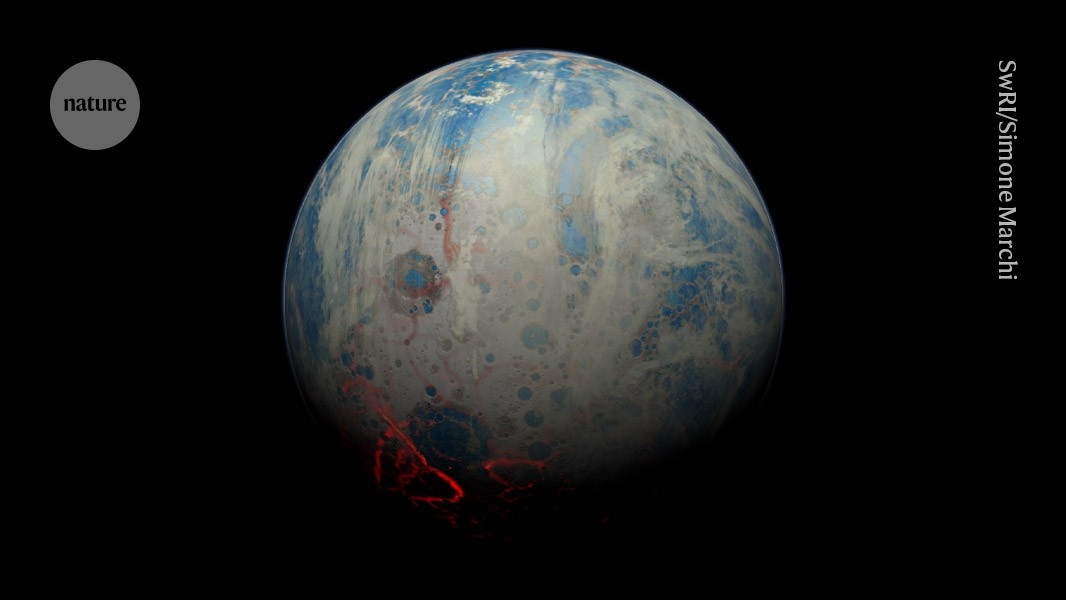Are these the world’s oldest rocks? Fresh data confirm contested claim

Scientists debate age of ancient Canadian crust as Inuit leaders work to preserve the location

An artistic impression of Earth during the Hadean eon, when the planet formed its first solid crust — most of which later sank into the mantle never to be seen again.Credit: SwRI/Simone Marchi
On the shores of Hudson Bay in northeastern Canada lie what could be the world’s oldest rocks. A study now suggests they are at least 4.16 billion years old — 160 million years older than any others recorded, and the only piece of Earth's crust known to have survived from the planet’s earliest eon1.
In 2008, researchers reported that these rocks dated back 4.3 billion years2, a claim that other scientists contested. Work reported today in Science1 seems to confirm that the rocks, known as the Nuvvuagittuq Greenstone Belt, are record-breakers.
Researchers say the rock formation offers a unique window into early Earth, after the planet cooled from its fiery birth 4.5 billion years ago.
“It’s not a matter of ‘my rock is older than yours’,” says Jonathan O’Neil, a geologist at Ottawa University who leads the research team. “It’s just that this is a unique opportunity to understand what was going on during that time.”
The ‘oldest rocks’ label has sometimes backfired. In the past few years, other teams have chiselled many samples out of the Nuvvuagittuq belt, leaving the landscape scarred. Last year, the local Inuit community closed access to the rocks to prevent further despoliation.
Only a handful of geological samples in the world date back to 3.8 billion years or older. Of those, the oldest undisputed rocks are found in the Acasta gneiss formation in Canada’s Northwest Territories; at 4 billion years old, they mark the boundary between Earth’s first geological eon, the Hadean, and the following one, the Archaean. Geologists have also found tiny mineral crystals dating back to the Hadean — such as 4.4-billion-year-old zircon crystals from Western Australia — that have become embedded into newer rock. But there are no known surviving chunks of crust from the Hadean — except, perhaps, the Nuvvuagittuq Greenstone Belt. It consists primarily of material that started out as volcanic basalt before undergoing various modifications during Earth’s tortured history.

The dark rock of Canada's Nuvvuagittuq Greenstone Belt could have originated from the basaltic lava of a volcano that erupted some 4.3 billion years ago.Credit: Jonathan O’Neil
In their 2008 work, O’Neil and his colleagues analysed the chemical imprint left by the radioactive decay of the isotope samarium-146 into neodymium-142 to calculate that the Nuvvuagittuq rocks were 4.3 billion years old. (Samarium-146 is a short-lived isotope that was depleted in Earth’s first 500 million years, and none was left after about 4 billion years ago.) Other scientists challenged that work, arguing, for instance, that Hadean-age crust had become mixed into younger crust, contaminating the results3,4.
For the latest work, O’Neil’s team analysed some once-molten rocks that had intruded into the main Nuvvuagittuq rocks like a knife cutting into a cake. By dating the intruded rocks, O’Neil and his colleagues were able to establish a minimum age for the cake itself. They used two radioactive clocks: the decay of samarium-146 into neodymium-142 and that of samarium-147 into neodymium-143. Both yielded ages of around 4.16 billion years for the intruded rocks. “If you don’t agree with this, then you need a very speculative, intricate model to get to the same answer,” says O’Neil.
Login or create a free account to read this content
Gain free access to this article, as well as selected content from this journal and more on nature.com
or
Sign in or create an accountdoi: https://doi.org/10.1038/d41586-025-02010-1
This story originally appeared on: Nature - Author:Alexandra Witze


















